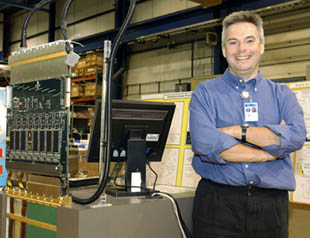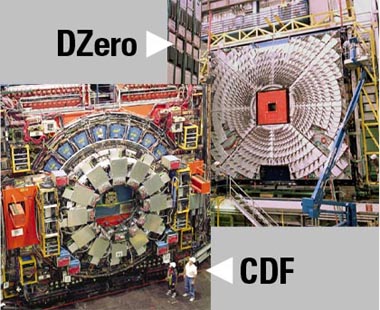 |
|
Point of View: RUN II
by John Womersley Last month Fermilab Director Mike Witherell announced the cancellation of the CDF and DZero silicon detector upgrades for Run II. While not entirely unexpected, this announcement was a great disappointment to many of us. I have lost count of how many times I have been asked how I feel about this decision. This brief article is an attempt to answer that question. It's a very personal view, not an official statement of laboratory or experiment policy. I haven't made any attempt at spin control, and aspects of the drama are still playing out, but I hope these words will prove helpful in the long run. When the announcement came, the first, instinctive, reaction was that the cancellation must not be allowed to happen. Personally, I have fought as hard as anyone for these projects and I did not want to see them stopped in their tracks. But there is a time for fighting and a time to move on. While the director was deliberating, I saw it as my right and responsibility to act as the strongest possible advocate for the silicon upgrade program. Now that the decision is final, for me to continue in that vein would be counterproductive. (It would be like arguing with a girlfriend who has left you; you'll never get her back that way. You have to move on.) It is time to accept what has happened, acknowledge our disappointment, draw a line under it, and focus on the future. It is important that we do not weaken the laboratory, damage our program, or divert effort from addressing the very real problems that face the lab—or from pursuing the physics we are doing here. Those of us very close to the projects may not be ready to acknowledge this yet, but to a large fraction of the high-energy physics community, the director's decision was the right thing to do.
Although it doesn't help to assign blame, it is, I think, useful to draw what lessons we can from this outcome. Make no mistake, this was not a good thing to happen. No one wants to be in the situation of approving projects and then canceling them a year later. There are two lessons that I think we can learn. First, we need to consider accelerator and detector projects together. In the case of the Run II upgrades, the detector projects were approved and started, but the accelerator came under scrutiny only later. Many of the assumptions made in going ahead with the detector projects had to be revised when the accelerator was reviewed. Second lesson: when there is a window of opportunity, one has to be able to move fast. In this case, the window for the detector upgrades closes once the LHC starts doing physics. But in the current atmosphere of project management oversight, the upgrade projects couldn't get off the ground without first going through seemingly innumerable physics, technical and project management reviews. These factors, coupled with a desire for conservative scheduling, in the end made them come online just too late to seem attractive to many people. One of my concerns is for the enthusiastic young team of physicists who have devoted their major effort to these silicon projects for the last few years. We should be clear, as the director has been, that the cancellation in no way reflects on their performance. The detector upgrades were on time, on budget, making excellent technical progress and moving into the production phase with assurance. We should all work hard to ensure that these people's careers do not suffer from the projects' termination. Within DZero, we have made it clear that we want every one of them to remain engaged in the experiment, and we will take steps to encourage them to move immediately into physics analysis activities without the requirement for a lot of additional service work.
I am "on the road" this fall, making the case in university colloquia wherever I can. (In fact this is being typed in Starbucks across the street from Columbia University in New York). I hope all CDF and DZero collaborators will do the same, with colleagues, with funding agencies, in whatever forums are available. In addition, the experiments are working with the Fermilab Office of Public Affairs on a new feature for FERMILAB TODAY, the "Fermilab Result of the Week." It made its first appearance on September 18, and has begun highlighting the broad range of incisive physics analyses that are coming out of the Tevatron. We didn't want this cancellation to happen—but now that it has, let's use it to our advantage. Let's use it to focus our own activities on making as strong a case as we can for the Tevatron, and getting the best damn physics we can out of the world's highest energy accelerator. After all, what else would we rather be doing? On the Web:
Dzero
CDF
Fermilab Today |
| last modified 10/1/2003 email Fermilab |
FRLsDFx9eyfrPXgV

 In arguing the case for the upgrades, I explained how this decision could, in my mind, lead to further descoping of the Tevatron program, perhaps even to its premature shutdown. Certainly the experiments do not want that; neither does the director; no one does. But I still worry for the future of our program. In the outside world, its image is compromised. We all have to get out and make the case for Run II as vigorously as we can. It is not a hard case to make: we are running the world's highest energy accelerator, and we expect fifty times the Run I dataset. We are the world's only source of W's, Z's, and top quarks. The top is the only Standard Model particle to couple strongly to the Higgs field—or whatever it is that gives fermions mass. It's a window on mass generation that should prove fascinating. After studying tens of top quarks for the last decade, we will soon have thousands of them. And this is a discovery machine: the Tevatron can roughly double our current reach in mass for supersymmetric squarks, gluinos and charginos. This is a great program!
In arguing the case for the upgrades, I explained how this decision could, in my mind, lead to further descoping of the Tevatron program, perhaps even to its premature shutdown. Certainly the experiments do not want that; neither does the director; no one does. But I still worry for the future of our program. In the outside world, its image is compromised. We all have to get out and make the case for Run II as vigorously as we can. It is not a hard case to make: we are running the world's highest energy accelerator, and we expect fifty times the Run I dataset. We are the world's only source of W's, Z's, and top quarks. The top is the only Standard Model particle to couple strongly to the Higgs field—or whatever it is that gives fermions mass. It's a window on mass generation that should prove fascinating. After studying tens of top quarks for the last decade, we will soon have thousands of them. And this is a discovery machine: the Tevatron can roughly double our current reach in mass for supersymmetric squarks, gluinos and charginos. This is a great program!